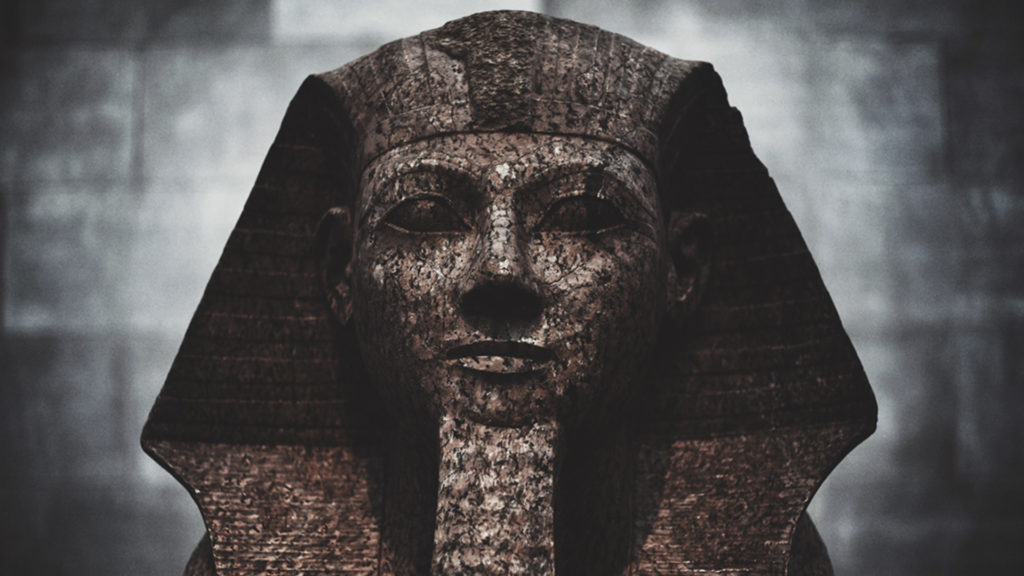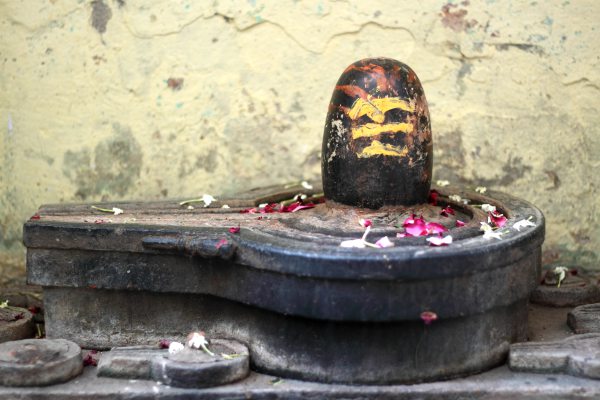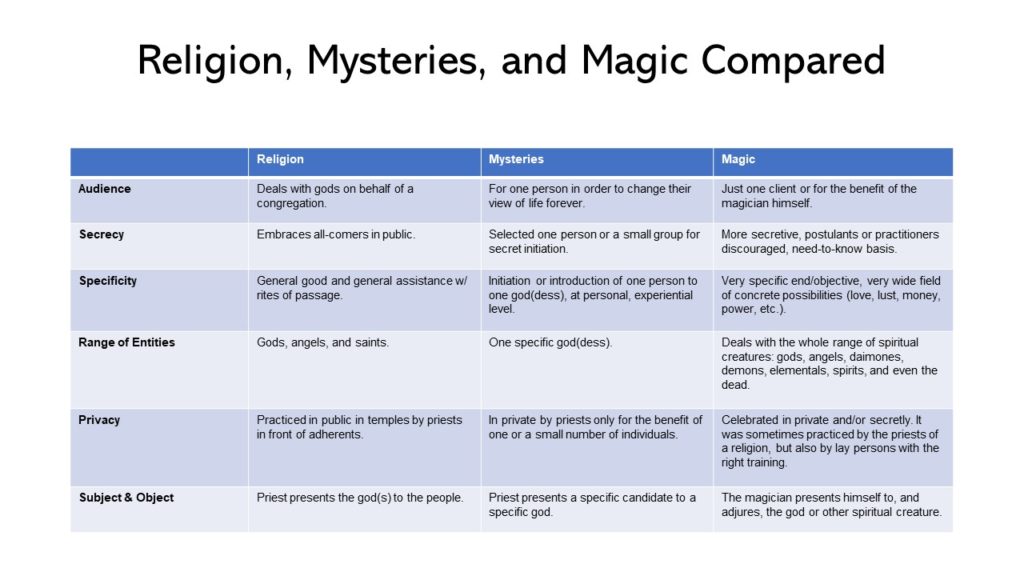A religious rite ought to form a religious community around a common ethos: a set of commonly held values that are both cause and effect of the commonly recognized highest power.
The Thelemic Background of the Gnostic Mass
The Book of the Law is the key to understanding the theology of the Gnostic Mass and its Creed.
The Sphinx and the Gnostic Mass

Part VIII of the Gnostic Mass—Of the Mystic Marriage and Consummation of the Elements—could be viewed as the formation of the Sphinx out of the Priest and Priestess (or the elements attributed to them, if you prefer).
The Sphinx represents the elements balanced in the individual. It is a hieroglyph of the individual who has made themselves an image in matter of the divine. The divine is the Phallus, the Pyramid, or the Sun, who the balanced individual is now the “bride” of.
Crowley specifically refers the Lion and the Dragon to the Beast and the Man and the Bull to Babalon. I take this to mean that the Sphinx is the balanced woman (Libra) or the Master of the Temple. This is another reason for Crowley’s cryptic remark at the end of Liber XV that the officers of the Gnostic Mass are all “parts of the Priest.”
Alternatively, man and woman coming together, at least under certain circumstances, could be seen as creating a third, divine entity.
It also offers another way to think about the “sacrifice of life and joy”. What’s being sacrificed is the unbalanced aspects of the elements. They are being united into a coherent whole, directed by the Will of the magician, and offered up to the Bridegroom, the Sun, for erotic destruction.
The Lord of the 5th Collect

The Lord of the 5th collect of the Mass is neither the Lord of the first collect (the Sun) nor the Lord of the second collect (the Lord secret and most holy).
He can’t be the secret and most holy Lord, because he is manifested. He is “the might of man” and is adored in places in nature, in temples and houses, and in our bodies.
He can’t be the Sun, either, because while the Sun is manifested (visible and sensible), the Sun is “our Lord in the Universe,” i.e., the god of the macrocosm or the demiurge. The Lord of the fifth collect, by contrast, is clearly associated with “the surface of the Earth” or the microcosm.
So what god or principle is manifested like the Sun but instead of being in the heavens is on the surface of the Earth?
“I believe … in one Father of Life, Mystery of Mystery, in His name CHAOS, the sole viceregent of the Sun upon the Earth…”
The Lord of the fifth collect must be CHAOS, the viceregent or representative of the rulership of the Sun upon the Earth.
The Sun is “represented” on Earth as light, as electromagnetic radiation. It is the energy of the Sun that allows plants to make food. It’s the energy that drives the weather and the transportation of water and many other natural processes necessary to life. Because of the light of the sun, the death of the individual is not the death of life itself. Life is renewed, and therefore death is no cause for sorrow. Hence the Sun is “light [and] life,” and the Lord of the 5th collect, Chaos, is “lord of Life and Joy”.
So then who are the saints? They are described as those who “adore” or who make “manifest [the] glory” of the Lord of the 5th collect. They are men who one way or another acknowledged the divinity of manifest, microcosmic existence, right here on Earth.
The saints are of the “true church of old time,” and their knowledge is passed down “generation unto generation.” In other words, their form of worship is not one which is necessarily taught any more than their churches are standing buildings. It’s more like a phylogenic memory of nature worship that’s passed down through the blood—or at the very least is self-evident to any with eyes to see or ears to hear. Christianity has buried this memory under heaps of superstition, but it can be reactivated whenever we engage external nature spontaneously and joyously through singing, dancing, and making love in a religious context.
“Religion must represent Truth, and celebrate it. This truth is of two orders: one, concerning Nature external to Man; two, concerning Nature internal to Man. Existing religions, especially Christianity, are based on primitive ignorance of the facts, particularly of external Nature. Celebrations must conform to the custom and nature of the people. Christianity has destroyed the joyful celebrations, characterized by music, dancing, feasting, and making love; and has kept only the melancholy.”
(Equinox III:1)
“Human nature demands (in the case of most people) the satisfaction of the religious instinct, and, to very many, this may best be done by ceremonial means. I wished therefore to construct a ritual [The Mass] through which people might enter into ecstasy as they have always done under the influence of appropriate ritual … I resolved that my Ritual should celebrate the sublimity of the operation of universal forces without introducing disputable metaphysical theories. I would neither make nor imply any statement about nature which would not be endorsed by the most materialistic man of science. On the surface this may sound difficult; but in practice I found it perfectly simple to combine the most rigidly rational conceptions of phenomena with the most exalted and enthusiastic celebration of their sublimity”
Aleister Crowley, Confessions
Such worship will awaken the innate, “essentially present” memory of the original worship. The “light” of the Sun will “crystallize in our blood”. It will come out of its dissolved, latent state and become an explicit awareness of the divinity of everything we see around us. We will come to a correct understanding of resurrection and no longer fear death. With its dramatization of the reproductive process and its celebration of all aspects of nature and life through the collects, Liber XV is such a ritual.
So the idea that the Lord of the 5th collect is CHAOS not only helps make sense of exactly who the saints are and why their church is the “true church”; it also explains exactly how the Mass fulfilled Crowley’s intention of creating a public religious ceremony that allowed people to enter into ecstasy—thus compensating for Christianity’s error—while also remaining on a purely naturalistic footing.
The Gnostic Mass as a Religious Rite
When interpreting the Mass, it’s important to keep in mind that it’s a religious rite, and so it’s not possible to capture the main idea behind it simply with categories that apply to magic(k), mysticism, or the mysteries of OTO.

This is a slide from my Minerval lecture summarizing Stephen Skinner’s treatment of these categories in Introduction to Techniques of Graeco-Egyptian Magic. I use this to show what is distinctive about initiation into a mystery school (such as M∴M∴M∴) versus attending Mass or doing private ritual at home. But it’s also useful for seeing what is distinctive about the Mass as a religious rite.
One of the main objectives of the Mass is implied by the Priest right at the start of the ritual: it’s to administer the virtues to the breathren. I think the simplest, most direct interpretation of that statement is that the ritual imparts the spirit of Thelema or the New Aeon to the public, both through its liturgy and through the eucharist itself.
To put a finer point on it, I disagree with an interpretation of the Mass according to which the Priest is exemplifying communing with his Holy Guardian Angel or Crossing the Abyss. That would be a mystical or magical interpretation. I think that renders the actions of the clergy excessively personal and private and tends to obscure the public cultic dimension. I think it also leads to the conclusion that the Priest is feeding his Holy Guardian Angel to the congregants (eww).
I have a long, detailed argument about what exactly is embodied in the eucharist. The short, simple answer is that it embodies the spirit that gave rise to the Book of the Law. So in yet another sense, the Book of the Law becomes your sustenance and comfort when you consume the bread and wine.
Now the spirit that gave rise to the Book of the Law is also the Holy Guardian Angel. (Crowley calls it Aleph, Harpocrates, and a bunch of other names.) So it’s easy to see why one would think that the Mass involves the Priest communing with his HGA. It’s actually not a stupid interpretation. And I could even accept an interpretation which said that the Priest communed with his HGA somewhere along the way in the ritual—or even that the congregants are there to do something similar. It’s not going to detract from it.
I just don’t think it’s the main objective of the ritual. It’s clear from the liturgy, from the presence of a congregation, from the ritualists taking up ecclesiastical roles, and just from things that Crowley said about the ritual when he was alive that the ritual is not meant to be simply mystical or magical, it’s meant to impart a particular kind of spirit (for lack of a better word) to the public. It’s meant to serve and help structure the self-understanding of a community.




